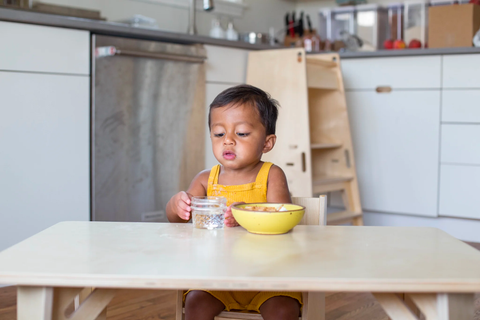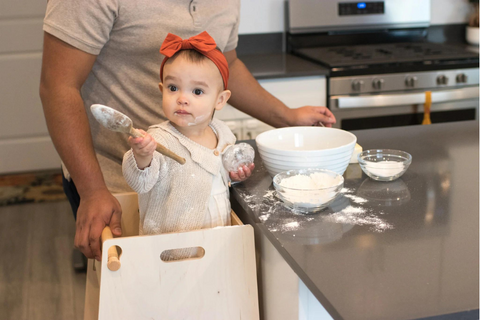You may have heard of the benefits of introducing breakable materials to young children: children learn about cause and effect, come to understand their own impact on their environment, and develop their spatial awareness and control of movement.
But how exactly can we introduce breakable materials to young children?
When to Start
There is no specific age that children will be ready to use breakable objects; it will vary depending on the child. Some signs of readiness to look for include the ability to sit at a table during snack time or mealtime, curiosity about adults’ glasses and plates, and drinking from a cup independently.
Start Small
Pick one object to start: perhaps a small drinking glass or small ceramic plate, and introduce the object at a neutral moment. You might sit at a low table with your child and show them an empty glass or plate, and allow them to feel it and hold it. You can let them know the material it’s made of (ex. glass or ceramic) and tell them that if it falls to the ground, it will break.

Start at a Low Height
When you notice that your child is able to sit at a small table and chair by themselves for a snack or a meal, they might be ready to begin handling a breakable drinking glass or plate. We recommend introducing this at a table that is low to the ground rather than when they are sitting at a high chair, so that if anything falls, it doesn't have very fall to travel! At first, you can encourage your child to leave the object at the table. You can tell them, “The plate stays on the table.” You might introduce walking while carrying breakable objects at a later time.
Store Objects at Your Child’s Level
Even before your child is ready to bring their dishware to the table independently, storing the materials in an accessible place supports your child’s sense of order, so that they know where to reach their materials when they are ready to carry them by themselves. Designate a shelf or a drawer in the kitchen where your child’s dishware is stored. You might want to keep only 1-2 of each material (glass, plate, fork, spoon, etc.) available at a time.
Have a Process in Place for Cleaning Up
Have your child observe you clean up the glass from an object when it breaks. Try to follow the same process each time, with the same materials, so that your child becomes familiar with the sequence of the clean-up process. You might store cleaning supplies in a place that your child will eventually be able to access, and increase their involvement in cleaning up as it is age-appropriate and safe to do so (this will be different for each child!)

What If They Throw the Objects on Purpose?
Some children might experiment with intentionally dropping breakable items. If this happens, you might say, “The cup broke. Let’s clean it up. We’ll try again tomorrow.”
If you see this pattern repeating, you can say something like, “It looks like you want to throw something. We can’t throw glass objects. Let’s throw this ball outside instead.”
As a reminder, try to use objects that you won’t be heartbroken to see break when you first introduce breakable objects to your little one! Some parents like to use empty glass yogurt pots or find small dishware at thrift stores that they can use while children are learning how to be gentle with these kinds of materials. As children continue to learn what their physical limits and the limits of the environment are, they will become more confident and controlled when handling delicate items.
Have you tried introducing breakable items at home with your little one?



